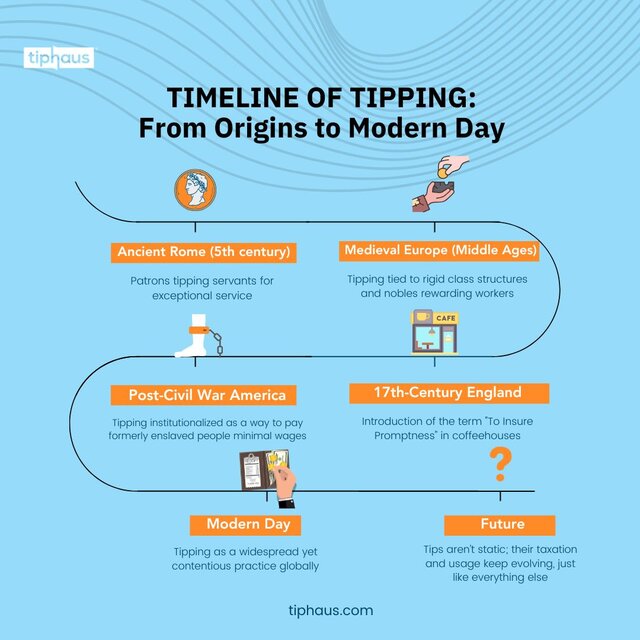
Tipping is a social norm that has become deeply ingrained in many cultures worldwide, but have you ever wondered where it all began? Did you know that tipping has roots in medieval Europe, where it wasn’t just a thank-you for good service but a power play rooted in class divisions? Or that the word "tip" likely originated in English coffeehouses as a clever acronym meaning “To Insure Promptness”? Far from being the universal norm it is today, tipping started as a practice reserved for the elite, evolved into a system of exploitation in post-Civil War America, and continues to spark debates over fairness and equity. This deep dive into the lesser-known history of tipping will uncover how a custom born out of societal hierarchies became an everyday act—and why it still raises eyebrows worldwide
Tipping refers to the practice of giving a gratuity, an additional payment to service in recognition of their work. While the specifics vary globally, the principle remains the same: rewarding effort, promptness, or exceptional service.

The concept of tipping can be traced back to ancient civilizations. The earliest records of tipping date back to the 5th century in Ancient Rome, where patrons would pay extra to servants for exceptional service. This practice was also observed in medieval Europe, where wealthy individuals would offer coins to their servants as a token of appreciation.
The practice of tipping became more structured during the Middle Ages, driven by the rigid class structures of the time. Wealthy nobles would provide small financial rewards to lower-class workers, reinforcing their societal positions. By the late Middle Ages, tipping became a common practice in Tudor England, where it began to reflect the social and economic divides of the era.

The term "tip" is believed to have originated in 17th-century England, where patrons would give coins to ensure prompt service. Some sources attribute the term to the acronym "To Insure Promptitude," which appeared on bowls in European coffeehouses. This idea of incentivizing service quickly spread, eventually taking root in America.
As tipping gained popularity in the United States during the 19th century, it sparked considerable debate. Americans first encountered tipping during their travels to Europe in the 1800s. Many saw it as a practice worth imitating, and it soon gained traction. However, tipping met significant resistance in the United States, where it was criticized as undemocratic and contrary to the nation’s values of equality. Some states even attempted to ban tipping, viewing it as a remnant of European aristocracy.
Following the Civil War, tipping became entangled with racial and economic inequality. Employers, seeking to minimize costs, shifted the burden of paying workers to customers through tips. Formerly enslaved people and immigrants were hired at minimal wages, relying on tips to make ends meet. This practice perpetuated classism and racism, as many patrons deliberately withheld tips from Black workers. The Pullman Company, known for its luxury railroad cars, played a significant role in institutionalizing tipping, employing formerly enslaved people as porters and encouraging reliance on gratuities to supplement low wages.
While tipping originated in Europe, its evolution has taken different paths worldwide. In many European countries, gratuity is often built into wages or included in service charges, ensuring workers earn a fair, livable income. In contrast, the American system still heavily relies on tipping to compensate service workers, creating ongoing debates about fairness and equity.
Here's a closer look at how tipping is viewed in different parts of the globe:

Today, tipping remains a contentious topic. Critics argue that it perpetuates economic inequalities, exposes workers to potential discrimination, and shifts responsibility from employers to customers. Despite these challenges, tipping continues to be a cornerstone of service industries worldwide. The future of tipping is uncertain, but trends suggest a gradual move toward wage standardization and automated tipping in many industries. As technology advances and labor activism grows, there may be a push to reduce reliance on tipping and adopt more equitable compensation models. However, cultural norms remain deeply ingrained, ensuring tipping won't disappear entirely anytime soon.
Tipping, while seemingly a simple act of gratitude, is steeped in cultural nuances, economic implications, and social expectations. Its evolution from medieval coin gifts to a cornerstone of modern service economies reveals much about societal values and inequalities. As debates over fair wages and tipping's role in equity continue, one thing is clear: tipping will remain a topic of interest and transformation for years to come.
Are you looking for tipping software that calculates everything from service charges to tip pools? We've got you covered.
Ready to ditch the spreadsheets and embrace a happier, more efficient workplace? Start your free trial today!